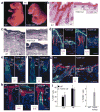Tcf3 and Tcf4 are essential for long-term homeostasis of skin epithelia
- PMID: 19718027
- PMCID: PMC2792754
- DOI: 10.1038/ng.431
Tcf3 and Tcf4 are essential for long-term homeostasis of skin epithelia
Abstract
Single-layered embryonic skin either stratifies to form epidermis or responds to Wnt signaling (stabilized beta-catenin) to form hair follicles. Postnatally, stem cells continue to differentially use Wnt signaling in long-term tissue homeostasis. We have discovered that embryonic progenitor cells and postnatal hair follicle stem cells coexpress Tcf3 and Tcf4, which can act as transcriptional activators or repressors. Using loss-of-function studies and transcriptional analyses, we uncovered consequences to the absence of Tcf3 and Tcf4 in skin that only partially overlap with those caused by beta-catenin deficiency. We established roles for Tcf3 and Tcf4 in long-term maintenance and wound repair of both epidermis and hair follicles, suggesting that Tcf proteins have both Wnt-dependent and Wnt-independent roles in lineage determination.
Figures








Comment in
-
Tcf proteins are deeply rooted in skin.Nat Genet. 2009 Oct;41(10):1050-1. doi: 10.1038/ng1009-1050. Nat Genet. 2009. PMID: 19786951 No abstract available.
References
-
- Merrill BJ, et al. Tcf3: a transcriptional regulator of axis induction in the early embryo. Development. 2004;131:263–274. - PubMed
-
- Nguyen H, Rendl M, Fuchs E. Tcf3 governs stem cell features and represses cell fate determination in skin. Cell. 2006;127:171–183. - PubMed
-
- DasGupta R, Fuchs E. Multiple roles for activated LEF/TCF transcription complexes during hair follicle development and differentiation. Development. 1999;126:4557–4568. - PubMed
Publication types
MeSH terms
Substances
Grants and funding
LinkOut - more resources
Full Text Sources
Molecular Biology Databases

